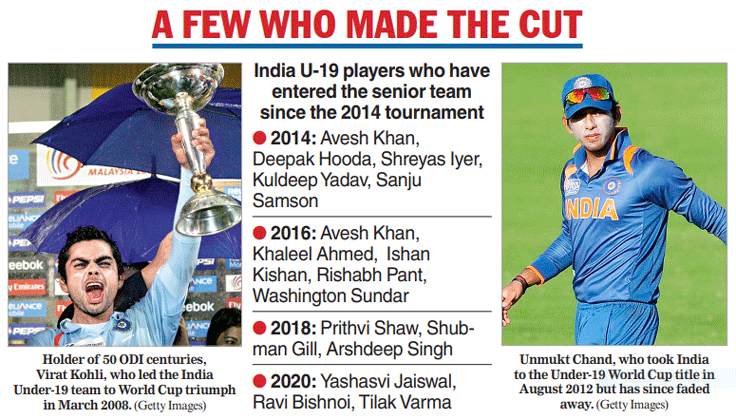A match-winning century against Australia in the final brought U-19 captain Unmukt Chand into the limelight during their successful World Cup campaign in 2012. The innings earned praise from Ian Chappell and he was thought to be the next big thing in Indian cricket.
The script, however, changed dramatically once the team returned home. The stars never aligned and he failed to make an impact when it came to making it to the national senior team.
A string of unsatisfactory scores in the Ranji Trophy and the Syed Mushtaq Ali T20 tournament never helped his cause as he was axed from the Delhi squad. He led the India A side but poor performances led to his ouster and even stints with the IPL franchises didn’t yield much.
Having failed to retain his spot for different teams, he eventually decided to relocate to the US and is now part of Major League Cricket there.
Chand’s career reflects a bitter reality: Success in U-19 never guarantees success at the senior level in international cricket. It’s a test of discipline and temperament. The fear of failure and the burden of expectations often weigh a player down. No wonder then that India’s strike rate of conversion from U-19 to international cricket has been poor — only around 27 per cent.
While Indian cricket is replete with success stories of players who have moved up from the U-19 level — Virat Kohli, Yuvraj Singh, Virender Sehwag, Mohammed Kaif, Harbhajan Singh, Rohit Sharma, Shikhar Dhawan, Suresh Raina and Rishabh Pant to name a few — it is also filled with instances of players who never made it to the next level.
When Kohli burst onto the stage as a precious talent in 2008 in Kuala Lumpur, it was Kanpur’s Tanmay Srivastava (262 runs in six matches) who was the highest scorer for
the team.
Srivastava made his first-class debut ahead of Kohli but their careers took different trajectories with Srivastava fading into oblivion.
“It is not easy at the international level. There is a huge gap in quality and players have to adjust to varying degrees of change in conditions. The responsibility increases and you have to keep pace with the changes. If you lose your focus, you are gone,” said a former India U-19 support staff member who spoke under cover of anonymity.
“The mental aspect takes precedence. Cricket at the highest level is 80 per cent mental and 20 per cent technical. You also have to struggle with injuries and loss of form... It’s not easy out there because destiny is in your own hands.”
Spinner Iqbal Abdulla, who played for KKR, and pacer Siddharth Kaul were joint-highest wicket-takers, along with Jadeja, in 2008 but they lost out in the race.
“Coping with the rigours of first-class cricket is never easy. It’s a different challenge altogether and you need to show maturity... Many players start doubting their abilities once they face failure in the journey ahead,” said a former national selector.
More than the technical aspect, “what carries more weight is the mental aptitude to understand the situation, adapt one’s game and have that insatiable hunger to perform each time,” Chand had said a few years ago.
Bengal’s Sreevats Goswami, a member of the 2008 U-19 champion team under Kohli, agrees.
“When you are at the senior level, you are in an ocean, where you come across several competitors. The competition thus is massively stiffer there... It’s all about survival of the fittest and those who can make the required mental adjustments faster succeed,” Sreevats said.
None from India’s World Cup-winning 2022 squad has so far made it to the senior level. Bengal’s left-arm quick Ravi Kumar, who was the second-highest among India’s wicket-takers in the West Indies, had been laid low by injuries.
“After the World Cup, I did play in some of the Syed Mushtaq Ali T20 Trophy and Vijay Hazare Trophy for Bengal.
But unfortunately, I sustained an ankle injury followed by a calf strain. It does get difficult at the senior level when you have to make a comeback,” Ravi said.
But what needs to be done to have more Kohlis than Chands from U-19 teams?
During his stint with Prithvi Shaw’s team, Rahul Dravid had reminded the players that they should not look upon this World Cup as the defining moment of their careers
but treat it as a stepping stone. That mental adjustment often makes the difference between success and failure.












